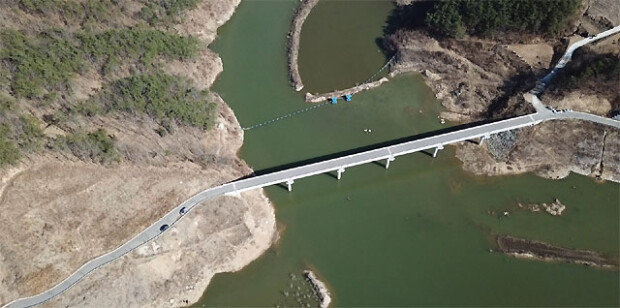Algal bloom is generated early at Yeongju Dam
Algal bloom is generated early at Yeongju Dam
Posted March. 29, 2018 08:12,
Updated March. 29, 2018 08:12

When we say dam, people usually recall an image of a gigantic stream of water flowing from the flood gate. But the scene of the Yeongju Dam in Yeongju, North Gyeongsang Province was quite different. When we visited the dam on last Tuesday, the ground was exposed except the area near the dam structure with a few puddles here and there. A red buoy that is supposed to be floating on water was left on the dry ground. A small dock meant to be built for boats was collapsed down on the cracked earth.
The water reserve rate of the Yeongju Dam that day was only 0.3 percent. The Korea Water Resources Corporation has been discharging water from the Yeongju Dam from the end of last month, leaving the dam at the lowest water rate. This is a measure against the algal bloom and black water that have been generated since 2016.
But the water was already greenish even though it was only in the middle of March. Algal blooms generally start to occur in the middle of April, when the temperature begins to rise. The algal bloom has occurred early this year as the temperature reached to 20 degrees Celsius on March 14.
The Yeongju Dam is a dam constructed in Naeseong Stream, which stretches out from Bonghwa to Yecheon and Yeongju. The dam construction started in December 2009 as part of the “Four River Restoration Project” of the Lee Myung-bak administration. The project ended in December 2012, but the Yeongju Dam construction, the last dam of the Four River Restoration Project, was completed in October 2016.
Civic groups and experts argue that the dam construction was wrong from the beginning. This is because there are many agricultural and dairy facilities in the vicinity, making it easy for fertilizer and manure to flow into the stream. In fact, we could easily see fields, where compost was applied, on both sides of the road on our way to the upper dam. “The occurrence of black water is likely to be caused by organic matters,” said Kim Jeong-wook, honorary professor at Seoul National University.
Experts point out poor environmental impact assessment as the reason. “At the time of the environmental impact assessment, the environmental problems that might occur in the future, including algal bloom and black water, should have been carefully studied, but it was nowhere to be seen,” said an official at the Ministry of Environment. In general, it takes a year for an environmental impact assessment to be completed as it takes into account seasonal effects, but the environmental impact assessment of the Yeongju Dam was conducted within five months.
whatsup@donga.com







